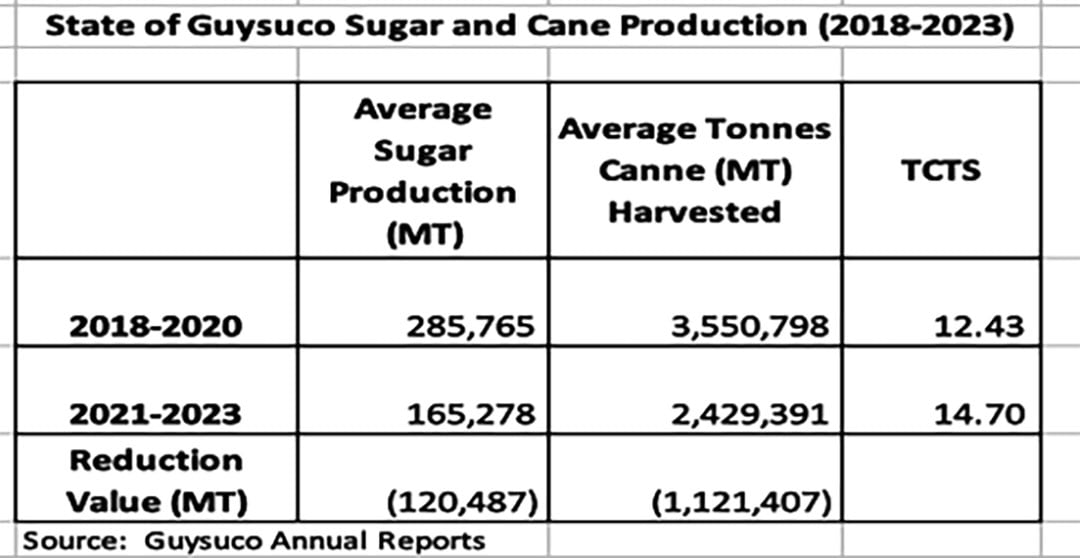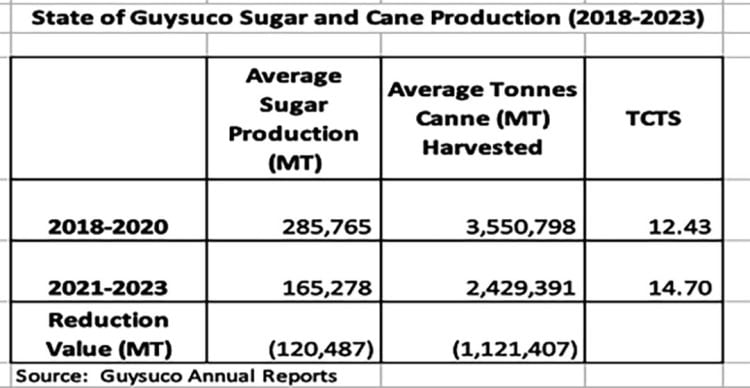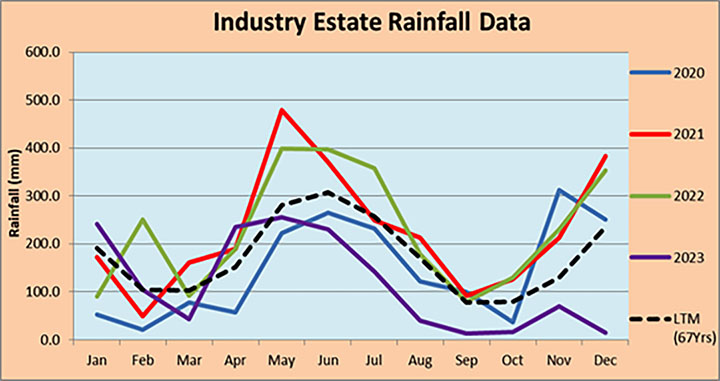Dear Editor,
I refer to a letter to the editor from one Raj Parmanand dated November 15, 2024. While it is not my aspiration to engage on this sugar matter publicly, it behooves me to at least clarify and set the records straight on what I think are good intentions from Mr. Parmanand, albeit he perhaps did not have all the information to wholly analyze. Fact 1 – the industry has an approved Strategic Plan for 2021-2026, which I am aware, if implemented (weather permitting), can generate conservatively 130,000 metric tonnes of sugar by 2026. Therefore, this whole question of the future of the sugar industry has to be framed in the following context: what was met in August 2020,
what was done since August 2020, what challenges were faced since August 2020, is the Industry on the road to 130,000 metric tonnes by 2026 and if not, what corrective measures are immediately needed to get back on that road-map that the Strategic Plan prescribes.
In my view, this is certainly not the time for the Industry to throw its hands up in the air, but rather to endorse the policy of the Government of Guyana and embrace the statement from His Excellency that “sugar is here to stay”. In fulfillment of the obligations of my current role, I am joining His Excellency and support his statements to the panel of journalists on the program called “In the Seat”. My input into this matter, however, will be confined to the periods before 2023 since I was not party to any of the strategic decision during the first and second crop of 2024. Therefore, all questions with regards to the operations in 2024 must and should be referred to the Chairman of the Board of Directors Mr. Madanlal Ramraj, in the case of the first crop of 2024 and in the case of the second crop of 2024, Mr. Paul Cheong, the Chief Executive, who I am told is now fully in charge of the operations.
Reading Mr. Paramanand’s letter has empowered me to recognize that it does not capture the fullness of the truth from August 2020 to the end of 2023. Therefore, to bring wholeness to his position, Editor, please permit me to add the necessary missing ingredients to allow the context of the situation to be properly understood. I will start with the table below:
From the actual evidence produced above, it begs the question, why did the cane production reduce by some 1.12 million tonnes during the period 2021-2023, when compared to the period 2018-2020. I offer three (3) vital reasons but there are more:
1. Fact 2 – The weather during the period 2018-2020 was 27% more favourable than the 67-year average Long Term Mean, while the corresponding weather pattern for the period 2021-2023 was 35% less favourable than the Long Term Mean. These rains that started in November 2020 culminated in the Great Floods of 2021, which the Government of Guyana declared a National Disaster (see detailed meteorological evidence below).
This situation caused severe flooding across the Industry during 2021, particularly in the cultivation at Albion Estate, the estate that was projected to produce 50% of the Industry’s production after the closure of several estates during the period 2017-2019. As a result of the Great Floods, the 2nd Crop of 2021 started very late (the first week of September 2021 at the main Berbice Estates – Albion). The evidence disclosed that after the Great Floods, there was a manifest deterioration in the stock of standing canes on all the Estates. Albion, the largest estate suffered the most damage (an estimated 70% of their fields were damaged with a 28% mortality rate in the canes). If the sales operations of Banks DIH in Georgetown are shut down, you cannot expect the New Amsterdam and Essequibo operations to fill the gap. That is the role Albion plays in the sugar industry; it is the mother ship.
The 2021 sugar production was 58,025 Mt as compared to the previous year of 88,868 Mt. The loss of cane in 2021, totaled 386,628 Mt across the Industry, as a result of this Great Flood, with an associated loss of sugar valued at approximately G$1.1 Billion.
The recovery time for sugarcane after being submerged in water for such an extended period cannot be expected to repair itself in 3 months; it is not rice. Because of the severity of the floods and the inability to drain the lands fast enough, the soil conditions deteriorated significantly which adversely influenced the presence of the required nutrients to stimulate healthy plant growth. Plus, most of the varieties were intolerant to this extended flood period and did not recover favourably in those waterlogged conditions at that time. While there were some green shoots of hope, those ratoons that survived exhibited characteristics of stunted growth, root damage, and a massive reduction of their sucrose content.
Repairing from this situation by October 2021 when the land was finally ready for rehabilitation, required 10 months and over 50 pieces of functional pertinent field equipment that were nonexistent in the Industry. Unfortunately for the Corporation, despite purchasing the equipment in 2021, the manufacturers advised that the equipment could only arrive in Guyana in the latter half of 2022. The Corporation even approached the private sector for compensated assistance but many of them were disinterested in the project in 2021 with the main reason given for their disinterest being, that they could not trust that they will be paid on time (a fair conclusion given the Corporation’s past track record).
This situation rendered most of 2021, and part of 2022 into a period of inadequate replanting. GuySuCo, using internal resource including a few pieces of old machines (with an average age of 14-17 years), set about preparing, and planting the land during those months immediately after the floods. To the credit of the team doing the work led by the Estate Managers, with inadequate and subpar equipment; they were able to rehabilitate and plant 1,561 hectares of land across the Industry. However, some 5,600 hectares of land were fully damaged by the Great Floods and still in need of immediate replanting if we were to recover to the pre-2020 levels.
It was only until late 2022, when the new field equipment arrived, and a renewed interest by the private sector, was some 2,641 hectares of land planted. At the start of 2023, there was momentum on the fields, and during that year some 4,584 hectares were planted. Fact 3 – the 5,600 hectares of damaged lands were finally rehabilitated, and replanted by September 2023. Therefore, the expected output from those 5,600 hectares of lands, were projected to fully manifest some 10 months after in September 2024. But I cannot speak to 2024, since it is a project in action and we have to wait until the year is over to fully analyze the situation. What I can tell you, as at the middle of 2023, there were newly planted “walls of cane” on all 5,600 hectares of land that were damaged during the 2021 Great Floods.
2. The state of the fields we (this team was led on the field by Mr. Yudi Persaud and Mr. Andre Paul) met in August 2020 had to be supported by field equipment that had an average age of 12-14 years old when it is normal to replace your equipment every 8 years. But despite the aged conditions, the field staff with full support from the field workshop team created magic to keep some of this fleet in motion. Additionally, more than 26% of the lands at Albion were inaccessible since some 40 bridges were destroyed due to old age over the previous decade, and there were no resources to rebuild them. With true grit, a small team including some young professionals (they know themselves), the Estate Managers, and a very supportive Procurement Committee under Dr Desmond Sears and Vice Chairman Jairam Pitam, Aslim Singh, Shameera Evans and Mohamed Raffik, set about getting the job done. Collectively we were able to put on the fields some 101 pieces of new equipment and sourced material to rebuild some 40 bridges across the Industry.
3. The state of the factories we (this team was led in the factories by Mr. Vijay Goberdhan and his three factory managers) met in August 2020 was one that survived by miracles and tenacity from a dedicated and determined team to keep those factories grinding. While such a strategy might have lasted for a decade or so, it could not work forever and a well-articulated, managed, and financed Factory Improvement Program was critical by 2021 but it was competing with the rebuilding of the Rose Hall Estate and the Field Rehabilitation and Replanting Program after the Great Floods for manpower, money, material, and management coverage. The priority was set.
One must never forget that the primary policy mandate of the Strategic Plan during the period 2021-2022 was to re-open Rose Hall Estate. The small pool of talent in the industry led by Mr. Vijay Goberdhan, went about doing two things – delivering on the policy mandate while at the same time doing their very best during 2021 and 2022, with the limited available resources, to keep the three factories at Albion, Blairmont and Uitvlugt grinding. A comprehensive procurement process started in 2021 but most of those parts arrived in late 2022 because of the major delays in shipments from Asia. Many parts had to be custom built for these very old factories. To complicate matters, in the middle of this project, the Uitvlugt Factory suffered a major breakage causing it not to grind in the first crop of 2022.
In all of this crisis, this small team was simultaneously busy degutting the Rose Hall Factory which was never decommissioned and had to be rebuilt from scratch, a project never attempted in all of the history of Guyana. This team did this project, with Guyanese talent. The record will reveal that the Rose Hall Estate was re-opened.
I leave the reading public to conclude on this matter since my marginal role here today is to state the facts and avoid the semantics.
Sincerely,
Sasenarine Singh



